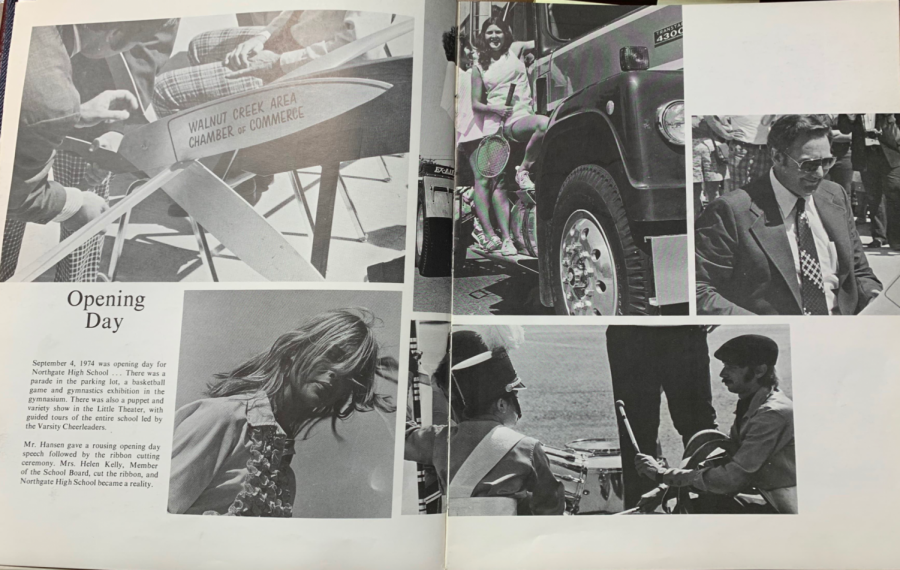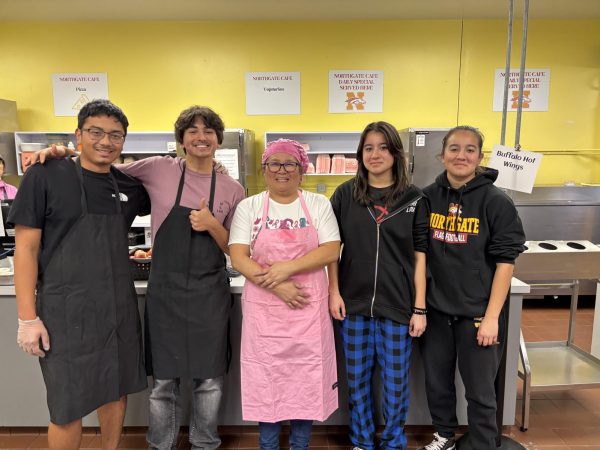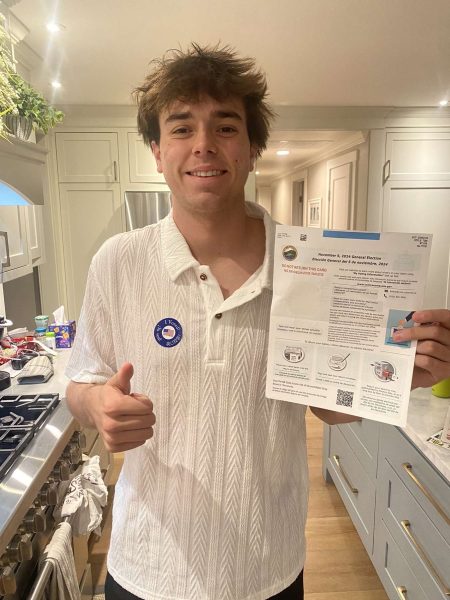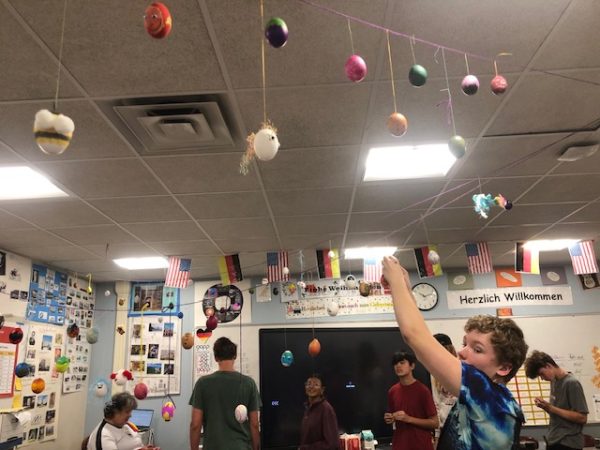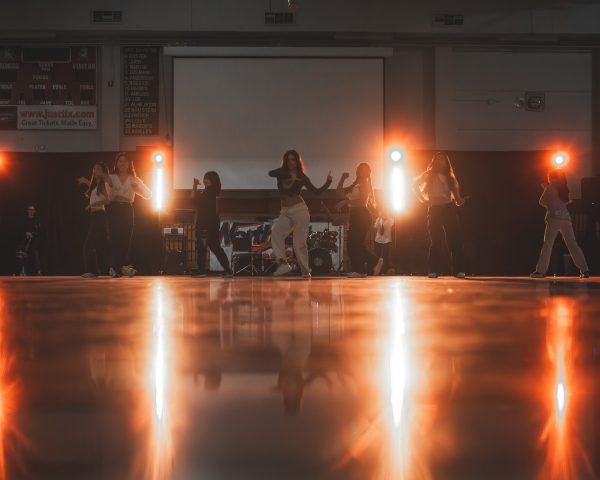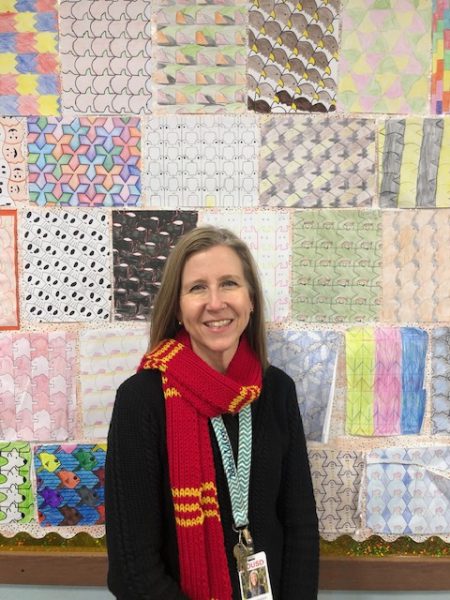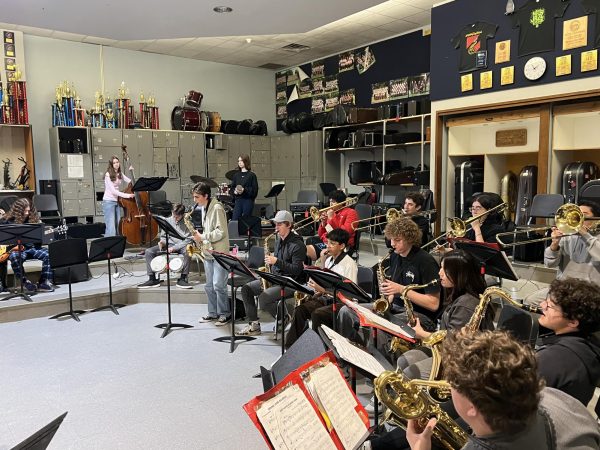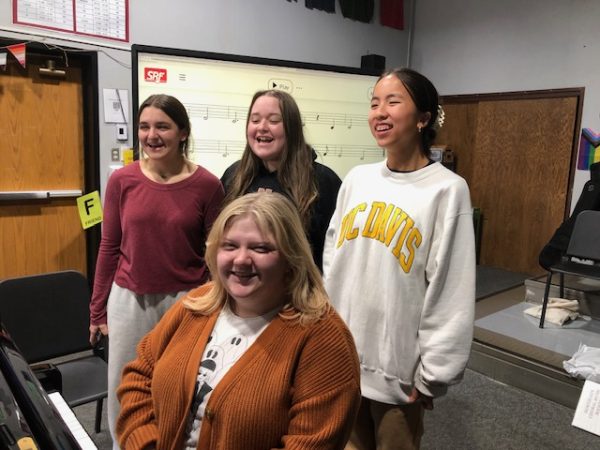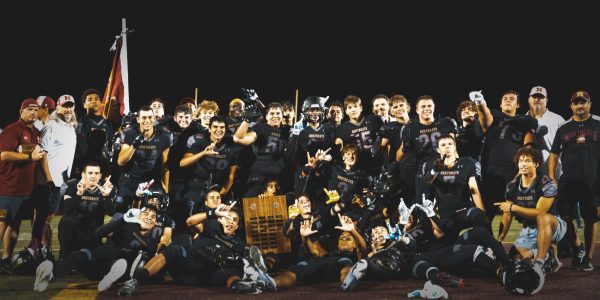College and Career Advisor recalls her high school days during the first years of Northgate
Diana Daymond returned to Northgate this fall, guiding students in their college application process after decades of unique international experiences in Asia as an architect, artist, and international swim coach
Diana Daymond, a student in Northgate’s first year, worked with seniors on their applications. She shared her life experiences, her memories and some of her photos including this yearbook page from Northgate’s opening day in 1974.
She has been around the world and back, following her love of working with students figuring out their ideal future and how to get there. Diana Daymond temporarily joined the college and career advising staff as an intern where she and Rebecca Proznick, Northgate’s College and Career Advisor, worked daily to guide seniors in writing their personal statements for college applications.
Daymond is no stranger to Northgate. She graduated from here in 1976 and went on to major in architecture at UC Berkeley, then to MIT and finally overseas where she raised her family and embraced diverse experiences. Her passion for art and swimming, plus three decades of living all across Asia as well as her experience of being a parent, informed her dedication to helping students. An experienced college advisor, Daymond returned to Cal to earn a specialized counseling certificate and found herself interning and interacting daily with teenagers at her alma mater.
Here are some of Daymond’s reflections from her time at Northgate and beyond:
What differences and similarities do you notice? First off, I think the student body is much more diverse than when I went here, reflecting the neighborhood, reflecting the community. You only came to Northgate if you lived right around Northgate. You couldn’t live in Concord or Pittsburg. So the district rules have changed, and that’s changed things. This was a very Caucasian neighborhood, some [diversity] but really pretty much Caucasian. This has been really great for me because I’ve been helping students write their college essays, and I’ve just met students with such interesting backgrounds. They’re from Pakistan or Iran; one student I was helping just moved from Africa. And so that, of course, has come into their writing about their college essay. I realize what the differences are, so that’s notable and, I think, really positive. The building is also different than it used to be.
Really? How so? I’m a retired architect and I am frustrated by the building. When they built it, they had this idea about open classrooms in the seventies. For example, all the English classes would be in one area, and there are just little low partitions. It was not separate classrooms. I’m the first to say it did not work very well. But then when they changed the school to make it into regular classrooms, there were a lot of classrooms that have no windows. They don’t have access to the outside or natural light. As a retired architect, I’m really about natural light and things like that, so it was a disappointment to see that. But on the other hand, I’m a competitive swimmer – we had a really good swim team when I was here, and it’s really fun to see the new swimming pool. So that’s very positive.
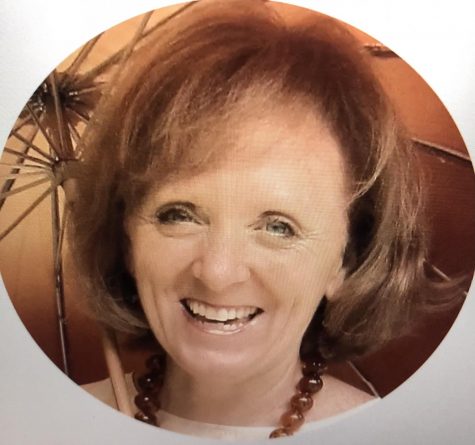
What are some highlights and best memories from high school? I only had two years at Northgate because even though I lived here the whole time, all of us went to Ygnacio Valley High School. It was an enormous high school – more than 4,000 students, and Northgate was already under construction. We knew that when Northgate got built, we would move schools. So that was a little strange. Even though we were at Ygnacio, they would have Northgate elections, and they’d have “Northgate this” and “Northgate that” and [at] an enormous school, it wasn’t a great experience. But at the same time, our sports teams were unbelievable. I mean, for everything, Ygnacio would win. So then, in 1973, in the fall, Northgate opened, and all of us who lived in this neighborhood now moved here.
Bronco Mascot: One of the funny stories I have is that we were still in Ygnacio and we had to “vote” on things. So we had to vote on our mascot, and I think there was a lot of influence that we’re near Berkeley and people are thinking bears and things like that. We kept voting and not until “the Broncos” won.
Selecting Crimson and Gold: The other thing was we had to choose the school colors. I think we had four elections for school colors, where we would vote for colors but there would be some reason we couldn’t do it. Finally, the two final choices were crimson and gold. [And we were told ], “Oh, you can have that;” because the adults had already decided. They’d already chosen the red lockers downstairs; they’d already chosen the carpeting that was ready to go. So they just wanted us to think we were voting even though we weren’t. So that was it, we were very excited to be the first people in the high school. It was, of course, brand new and everyone was excited because it was a whole new principal and whole new teachers.
Traditions? Some are the things that you have still now, like homecoming. I was very sporty and I think a big difference is that there are a lot more opportunities for sports now for girls, [since back then] they didn’t really support women’s sports. But that was not just Northgate, that was the district in general. I remember that. The women, the girls, the girls’ coaches, in general, they’d get $500 for all their work in the season and the coaches went on strike because it wasn’t enough. So we went a whole year with no girls’ sports because they weren’t gonna pay them enough [to coach]- they weren’t paying anything like the boys’ sports. So that’s probably a very big difference that you have those options.
Describe your architectural path to Asia: I moved to Boston to go to graduate school. I always thought I’d come back to California. I’m like, “Oh, of course, California. So great. I’m gonna come right back.” But no, actually, I met my husband in high school – he went to Ygnacio, I went to Northgate, and we went to Berkeley together. Then he was at Harvard when I was at MIT and then we got married. He does developmental economics, and he worked for an international organization called the World Bank, which helps disadvantaged countries around the world. Long story short, I was practicing architecture in Boston. Now, architecture doesn’t really pay that well. I had two little kids that I paid more for childcare than I made. My husband’s boss said, “Why don’t you guys move to Indonesia and you can do the job there?” We moved to Indonesia, and I started practicing architecture there. I usually did smaller things like nursery schools, schools, offices, housing interiors, that kind of thing. We lived in Indonesia for five years, which was fantastic, [it was around] 1989. When that job was done, we were supposed to move to Nigeria, or Kazakhstan, for the World Bank, and we [were hesitant] because of the kids and so we said, “Let’s try Hong Kong,” because we had an opportunity to move to Hong Kong for 14 years, and that was good. Then we moved back to New York for a few years, then Singapore for five years. Next, we moved to Malaysia, back to Hong Kong again for two years, and then Malaysia for two years. I just moved back to the United States after almost 30 years in Asia.
Describe your experience in art: I think my art now has a lot of influence from Asia. While I lived in Asia, one of my jobs was in contemporary art museums, doing education programs, like the Singapore Art Museum and Malaysian Museum. I was really plugged into the contemporary art community and that would influence me as well. It was mostly botanicals, nature.
When I was at Northgate, I felt really discouraged to pursue art because serious students didn’t do the art classes or the home ed classes or shop classes; you only stuck to the A through G classes, but not even art. Even though I was very interested in art, I didn’t really do it at Northgate and then I realized when I was in college that, yes, that is how I want to go. So in graduate school, I did architecture. I went to graduate from Berkeley, and then I did my architecture at MIT. So I did the architecture and the art, which are all intertwined.
International Experiences? In Asia, of course, we traveled everywhere. We had some crazy stories. We lived in Hong Kong in 2003, when there was the SARS virus. That shut schools down just like here for the beginning of COVID. My daughter was a junior in high school, my son was in eighth grade and they shut everything down. So we came back here, and actually during that time, my daughter went to Northgate. She was a junior in high school and once they gave her the go ahead that she was not sick, she did the rest of her junior year here. Then she went back to Hong Kong for her senior year. So I kind of saw the school again during that time, but it was only for a number of months. I could talk forever about Asia. If anybody’s traveling to Asia or moving to Asia, definitely give me a call because I could give them very detailed information on those countries that I lived in. We just came back because of Covid. We found that we really enjoyed the culture and traveling and our children growing up there. I could always work as an architect, but I also worked as a swimming coach. That was a skill that I had; people can never find a good Western swim coach. So I was head coach of the different international school teams. That influences my work now because I work a lot with athletes, like the recruiting process. And artists, of course, I like working with artists and architecture students. I work with everybody, but those are my specialties.
What sparked your inspiration to become a career advisor? Gosh, that was a long journey and what’s really informed me for helping students now is that when I was in high school, I started coaching swimming. I was a very serious swimmer. I went to the Olympic trials in 1976, but I always really loved coaching kids. And all the time I was in college, I was a swim coach in the summers; I was head coach at the Ygnacio Woods swim team. When I was in Asia, people just saw that I could swim and they’d ask me to swim. So I realized I’d like coaching high schoolers a lot. I don’t usually just help kids write essays. I usually coach kids starting in 10th and 11th grade to help them think about their career path. It’s just something I’ve enjoyed. I fell into it in Asia, because I knew a lot about it, and people in Asia didn’t know about it. I lived in Hong Kong, and I had some very good swimmers. At the time, I was giving interviews for MIT applicants. Through that, I was working with the MIT admissions office, and I understood the process, and then I had very good swimmers. I said, “You know, I think you could be recruited athletes. But you’d have to get into these Ivy League schools.” My first two students got into Harvard and into Princeton. My reputation kind of grew. People were like, “Oh my gosh, how did you do that?” Of course, they did the hard work, not me. I just kind of showed them a way.
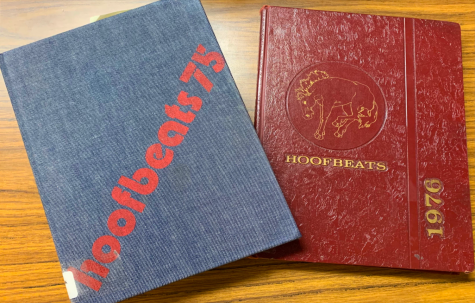
You pulled out some yearbooks – flip through pages and tell about them: Okay, so this is 1975, Northgate’s first yearbook. This is so goofy. I remember thinking at the time, “why are the first 10 pages of photographs just of the yearbook staff?” Going to the activities, you can see there’s wood there that’s painted now. Here are some differences over in the art area. They had these great homemaking kitchens which I noticed are not here anymore. They had a shop doing industrial arts, like how to fix your car. I don’t think those classes are over there anymore. It was a very dedicated group of teachers. They were super excited because it wasn’t a group [they’d already had]. Some of the teachers came from Ygnacio, but most were new.
First day of Northgate: So this is the opening day of Northgate, our first day. September 4, 1974, was the first day Northgate existed for students. I remember the cheerleaders were so cool. It seems now like there’s a rally group and everything, but back then there were just 10 cool girls who were cheerleaders.
The building: I think one of the disappointments even at the time was that it’s really a beautiful setting and you never look out; you don’t see the mountain behind you. It’s so glorious, that mountain, and the weather is so nice. So how come we’re always indoors all the time? It bothered me at the time, bothers me still. I mean they joke that it’s like a prison, but it really is like one. These guys are sitting on the grass where the pool is now. We always had rallies and things out here sitting on the grass and it was like a hillside.
Society and culture: One thing I think at the time, in the ‘70s, I think there was a lot more drugs at the time. I remember it was kind of a thing. Not personally that I knew, but it was a rougher time, kind of like Berkeley and the whole Free Speech Movement and we weren’t very far. Only recently had girls been allowed to wear pants to school and it had only been in the last four or five years, if you can imagine. You couldn’t wear pants to school before that, but of course now everybody was wearing pants to school.
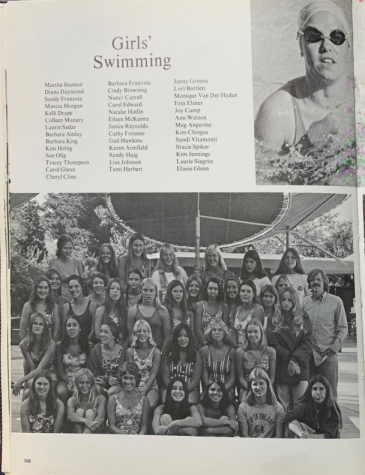
Sports: A lot of boys’ sports compared to girls’ sports. I think that’s me. We were a really good swim team. It was the first year, we won North Coast. Right here the number one meet was the Invitational, and we got 120-80. That was our first year at Northgate. In the second year, we didn’t have a team because they didn’t want to pay the coach. We won the league championship, we won everything. So two-thirds of the pages that you see are all boys doing sports. So that’s a big difference, I think. There was no senior class. The seniors stayed at Ygnacio; they didn’t think it was very nice to have them move there last year. Here’s my junior picture. Of course, it’s all in black and white. Here’s the library now- it looks kind of the same, more books back then.
Rivalry: Now this is the ‘76 yearbook. This is all about the rivalry between Northgate and Ygnacio Valley. So they’re talking about wins, tradition. So senior picnic, first year for senior picnic, senior dance, senior prom – it was the first year for anything senior. Cross country team…we won North Coast. I ran cross country too.
Returning impression: I think you have a lot more pleasant things now. It took a little while to get it going. I think it was a good school – I mean, it was a good school then, it’s a good school now. People are proud to graduate from it.
What now? Now, just moving back last year to America, I decided I’d like to just do college counseling full time. So that’s why I did the Berkeley program, and that’s why I’m doing this now. I think if you show high schoolers their future, the possibility of their future, I think it inspires them to be better students, to be more engaged, to take it seriously early on. So when it comes time to apply for college, they kind of know what they’re doing already. They have an idea about what their profession might be. They have an idea what kind of school they might want, and then they’re usually more successful in college…that’s just something that I have been passionate about, and kids seem to like to work with me.

